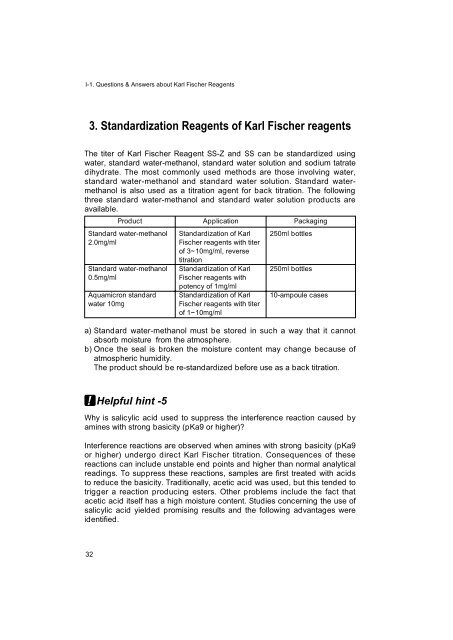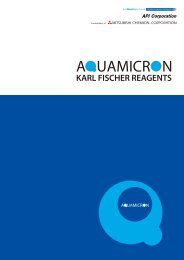Development of Karl Fischer Reagents
Development of Karl Fischer Reagents
Development of Karl Fischer Reagents
You also want an ePaper? Increase the reach of your titles
YUMPU automatically turns print PDFs into web optimized ePapers that Google loves.
I-1. Questions & Answers about <strong>Karl</strong> <strong>Fischer</strong> <strong>Reagents</strong><br />
3. Standardization <strong>Reagents</strong> <strong>of</strong> <strong>Karl</strong> <strong>Fischer</strong> reagents<br />
The titer <strong>of</strong> <strong>Karl</strong> <strong>Fischer</strong> Reagent SS-Z and SS can be standardized using<br />
water, standard water-methanol, standard water solution and sodium tatrate<br />
dihydrate. The most commonly used methods are those involving water,<br />
standard water-methanol and standard water solution. Standard watermethanol<br />
is also used as a titration agent for back titration. The following<br />
three standard water-methanol and standard water solution products are<br />
available.<br />
Product Application Packaging<br />
Standard water-methanol<br />
2.0mg/ml<br />
Standard water-methanol<br />
0.5mg/ml<br />
Aquamicron standard<br />
water 10mg<br />
a) Standard water-methanol must be stored in such a way that it cannot<br />
absorb moisture from the atmosphere.<br />
b) Once the seal is broken the moisture content may change because <strong>of</strong><br />
atmospheric humidity.<br />
The product should be re-standardized before use as a back titration.<br />
!<br />
32<br />
Helpful hint -5<br />
Standardization <strong>of</strong> <strong>Karl</strong><br />
<strong>Fischer</strong> reagents with titer<br />
<strong>of</strong> 3~10mg/ml, reverse<br />
titration<br />
Standardization <strong>of</strong> <strong>Karl</strong><br />
<strong>Fischer</strong> reagents with<br />
potency <strong>of</strong> 1mg/ml<br />
Standardization <strong>of</strong> <strong>Karl</strong><br />
<strong>Fischer</strong> reagents with titer<br />
<strong>of</strong> 1~10mg/ml<br />
250ml bottles<br />
250ml bottles<br />
10-ampoule cases<br />
Why is salicylic acid used to suppress the interference reaction caused by<br />
amines with strong basicity (pKa9 or higher)?<br />
Interference reactions are observed when amines with strong basicity (pKa9<br />
or higher) undergo direct <strong>Karl</strong> <strong>Fischer</strong> titration. Consequences <strong>of</strong> these<br />
reactions can include unstable end points and higher than normal analytical<br />
readings. To suppress these reactions, samples are first treated with acids<br />
to reduce the basicity. Traditionally, acetic acid was used, but this tended to<br />
trigger a reaction producing esters. Other problems include the fact that<br />
acetic acid itself has a high moisture content. Studies concerning the use <strong>of</strong><br />
salicylic acid yielded promising results and the following advantages were<br />
identified.




